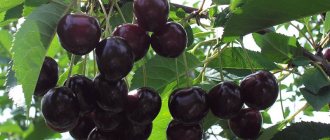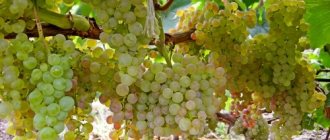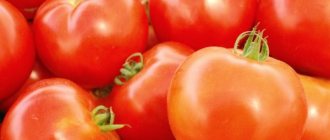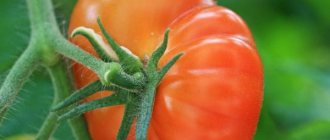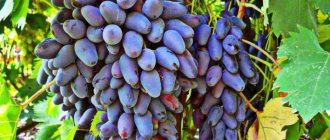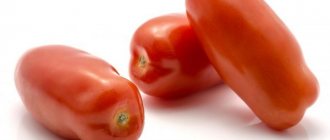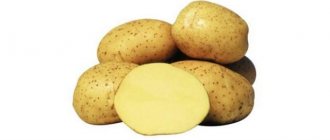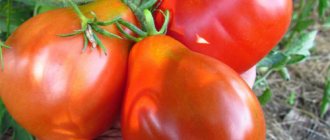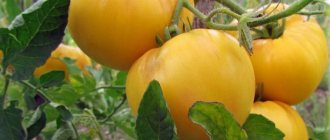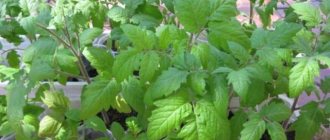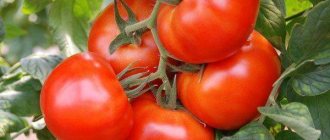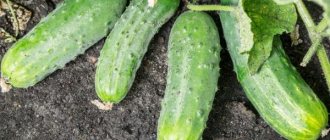Fruits and berries » Grapes
0
962
Article rating
Kira Stoletova
Every year the number of new grape varieties increases. Not all of them are characterized by high yields and disease resistance, so gardening critics do not recommend them for planting. Grapes Gift to Irina are among those crops that have received positive reviews and are suitable for growing in gardens.
Description of grapes Gift to Irina
Characteristics of berry crops
The variety “Gift to Irina” “absorbed” the best qualities of its parents. The berries are suitable for fresh consumption, processing into juice, jam, jam. Not recommended for use in wine making. The intoxicating drink turns out to be almost tasteless. The fruit ripening period is early, 125-130 days. Fully ripe berries are harvested in August. The berries are not prone to cracking.
The plant is moderately resistant to frost; the vine and buds do not freeze if the temperatures do not drop below -23°C. Resistance to fungal diseases and pests is average. Excellent resistance to gray rot and mildew.
Note to gardeners! To prevent the crop from getting sick, it is necessary to carry out preventive treatments with fungicides.
The flowers are bisexual, so for pollination there is no need to plant pollinating varieties nearby. The yield per bush is 12-15 kilograms.
Description of grapes
The bushes are medium-sized, not densely leafy. The leaf blades are smooth, broad-lobed, and colored deep green. The vine ripens well, but not along its entire length. The clusters are formed in a cone shape. The mass of one reaches 0.8-1.5 kilograms. The brushes are dense, the berries do not pea. The berries are firmly attached to the branch and do not fall off when overripe and transported over long distances.
The fruits set and grow oval-elongated in shape. The skin of the berries is dense, covered with a waxy coating, and painted in a beautiful pink-burgundy color. On average, the weight of the berry is 15-20 grams. The pulp is dense, fleshy. When bitten, it bursts pleasantly. You immediately feel a sour taste, and then a marmalade sweetness.
Advantages and disadvantages
Despite the fact that the variety was bred in Ukraine, it quickly became popular among winegrowers in the CIS countries. Russia was no exception. Most often it is cultivated by gardeners from the southern regions, but even in the middle zone, it does not lose its popularity. The berry crop attracted the following advantages:
- high and stable yield;
- large fruit and lack of peas;
- average resistance to diseases and frost;
- harmonious taste of fruits;
- density of bunches;
- high transportability;
- the berries do not crack due to excessive moisture in the soil;
- self-pollinating.
Disadvantages of the plant:
- it is necessary that it does not freeze;
- is attacked by birds and wasps.
What to pay attention to when landing
Like many varieties, the hybrid Gift to Irina is best planted in an area with loamy or chernozem soil. The acidity level should not exceed the 3% threshold. The plant is demanding of sunlight, so choose an open place for planting, but without constant drafts. The maximum height of a seedling is up to 700 mm.
When purchasing, be sure to pay attention to the obligatory condition of grafting the crop onto a rootstock; such a plant has the best characteristics of resistance to pests and diseases. In advance of planting seedlings, holes are dug in marked areas, the depth of which is up to 600 mm and the width from 500 mm.
The top fertile layer of soil is mixed with 3-5 kg of manure, 200 g of superphosphate and 300 g of ash are added. The bottom of the pit is filled with a 100 mm layer of broken brick or expanded clay for drainage, then a layer of nutritious soil is filled in, pouring it into a slide. A seedling is placed on the mountain, each root is carefully and carefully straightened and the roots are gradually covered with prepared soil.
In advance of planting seedlings, holes are dug in marked areas, the depth of which is up to 600 mm and the width from 500 mm. The top fertile layer of soil is mixed with 3-5 kg of manure, 200 g of superphosphate and 300 g of ash are added. The bottom of the pit is filled with a 100 mm layer of broken brick or expanded clay for drainage, then a layer of nutritious soil is filled in, pouring it into a slide. A seedling is placed on the mountain, each root is carefully and carefully straightened and the roots are gradually covered with prepared soil.
The hole is filled with 20-30 liters of water, the seedling is slightly raised and completely filled with soil. You need to leave a 50 mm distance at the top and cover it with a layer of mulch. The minimum gap between plants is 4 m.
About care
The Podarok Irina grape variety is planted only on loamy soils or black soil.
The acid-base balance in the soil should not exceed 3%. Choose open areas that receive sufficient sunlight. The height of a seedling suitable for planting should be 50-70 cm. A few weeks before planting, they begin to prepare the hole. Its dimensions should be 50x60 cm. The remaining soil, after digging, is mixed with 20 g of superphosphate and 3 kg of humus. A drainage system is installed at the bottom and 2 kg of mullein are laid out. After 10-15 days they begin planting.
Plants should be watered as needed
Watering is carried out as the soil dries. There are no exact recommendations for the regularity of watering. It all depends on the climatic conditions of your region. When watering, pour at least 20 liters of warm, settled water under each bush. After each watering, loosen the soil or remove weeds. To avoid pulling out weeds every week, it is worth mulching the soil with straw and humus, which will reduce the growth of weeds and prevent a crust from forming on the soil surface.
Feeding
Feeding is carried out as needed. If the onset of fruit ovaries is delayed, fertilize with a solution of potassium nitrate (30 g per 10 liters of water). If there are problems with fruiting - delay or a small number of bunches on the bushes - water the plant with a superphosphate solution (40 g per 10 liters of water). In the fall, mulch the soil with humus to protect the crop from winter frosts.
Pruning is carried out in the spring. At this point, dry and unfruitful areas are removed. Thinning of the shoots is also carried out to increase the fruiting of the bush. Such regenerative pruning has a positive effect on crop growth and productivity.
“Gift to Irina” is an early-ripening table grape variety. The berry crop was developed by an experienced breeder from Ukraine, N.P. Vishnevetsky. He took materials from two varieties as a basis: “Kesha” and “Elegant”. Grapes are classified as hybrids. Suitable for cultivation in the southern regions and central Russia. It is not recommended to cultivate in the North; it freezes in winter.
Grapes Gift to Irina are not a capricious variety.
- The variety is not afraid of rainy and humid weather, but nevertheless, like any representative of this crop, it prefers a dry, sunny place. To avoid provoking the formation of mold and fungal diseases, build some kind of shelter or small canopy for the plant. This will protect the vine leaves from excess moisture.
- Drying of the roots is unacceptable. Water the grape bushes at least once every 7-10 days. When watering, also try to avoid getting water on the foliage; this will protect the leaves from getting burned in hot sunny weather.
- In the spring, be sure to clear the ground around the bushes from last year's foliage, in which spores of pathogenic fungi could form. To prevent the spread of diseases, it is better to burn the foliage.
- Avoid the appearance of weeds, remove them in time. This will give the roots the opportunity to receive the necessary oxygen.
- During the growing season, fertilizing plays an important role. If the soil is depleted, this will definitely affect the harvest. The plant itself will tell you that it needs feeding: the leaves will begin to turn yellow, become withered, and “sad” in appearance. Help the plant with potassium, phosphorus and organic fertilizers.
- Carry out the correct formation of the bush. Promptly remove dried, diseased or unnecessary branches that block the path to sunlight.
- Periodically inspect the bushes for mildew or oidium infection. These are the most dangerous diseases for the vineyard.
Like many varieties, the hybrid Gift to Irina is best planted in an area with loamy or chernozem soil. The acidity level should not exceed the 3% threshold. The plant is demanding of sunlight, so choose an open place for planting, but without constant drafts. The maximum height of a seedling is up to 700 mm.
In advance of planting seedlings, holes are dug in marked areas, the depth of which is up to 600 mm and the width from 500 mm. The top fertile layer of soil is mixed with 3-5 kg of manure, 200 g of superphosphate and 300 g of ash are added. The bottom of the pit is filled with a 100 mm layer of broken brick or expanded clay for drainage, then a layer of nutritious soil is filled in, pouring it into a slide. A seedling is placed on the mountain, each root is carefully and carefully straightened and the roots are gradually covered with prepared soil.
The hole is filled with 20-30 liters of water, the seedling is slightly raised and completely filled with soil. You need to leave a 50 mm distance at the top and cover it with a layer of mulch. The minimum gap between plants is 4 m.
According to approximate data, there are about 5 thousand different varieties of grapes in the world, of which approximately 3 thousand are grown in the CIS. The most popular are table forms of grapes, the fruits of which can be eaten fresh.
They are valued, first of all, for their medicinal properties, attractive appearance of the bunches, pleasant aroma and wonderful taste. One of these varieties is Podarok Zaporozhye.
Let’s take a closer look at what characteristics this variety has and whether it’s easy to grow it yourself.
Gift to Zaporozhye (synonym FVC-3–3) is a hybrid grape of Ukrainian selection, bred relatively recently (in the 80s of the 20th century). The author of this creation is Zaporozhye breeder E.A. Klyuchikov. This variety was created by complex crossing of three complexly resistant varieties:
- Kesha-1 (FV-6–6);
- Tsytsa resistant (V-70–90);
- Esther (R-65).
A gift to Zaporozhye - the result of crossing several grape varieties
Despite its short history, Podarok Zaporozhye grapes have become widespread not only in Ukraine, but also in almost all regions of Russia, attracting winegrowers with their fertility and unpretentiousness.
The pulp of Podarok Zaporozhye grapes is very juicy, but at the same time not watery
Gift to Zaporozhye belongs to the early-middle grape varieties with a ripening period of 135–145 days. Fruiting of a young plant begins 2–3 years after planting. The vine ripens early.
In the middle zone, harvesting is carried out in late August - early September.
In this case, ripe clusters can remain on the bush until the second ten days of October, provided there is no frost.
A bunch of Gift to Zaporozhye consists of large berries of the same size and can reach a weight of 1.5–2 kg
Gift to Zaporozhye has one distinctive feature - its berries first gain size, and then they ripen. The taste of the berries is not very rich, but harmonious, there is a slight apple flavor.
The flowers of this grape are functionally female, so it is recommended to plant a bisexual variety with identical flowering periods next door. In this case, pollination occurs without problems in any weather conditions.
Many are attracted by the high yield of this variety - the fruit yield is more than 70%. A characteristic feature is the tendency of the bush to be overloaded with crops, so measures are required to standardize the inflorescences. Without these procedures, peas will be observed.
The bush tolerates frosts well down to -24 0C. Nevertheless, in the central and northern regions it is recommended to cover and insulate the plant for the winter.
One of the properties of Gift to Zaporozhye is its high resistance to mildew, and rarely suffers from oidium. The main pests that can damage the dense skin of fruits are birds.
READ MORE: Tomato parsley gardener characteristics and description of the variety, yield with photos
Despite the stated characteristics of the absence of cracking of berries, many winegrowers note this drawback, especially after heavy rains. It is recommended to remove damaged fruits with cracks to avoid wasp attack and subsequent rotting.
Due to excess moisture, the berries may crack, losing their presentation.
Ripe bunches of Gift of Zaporozhye should be transported in a special way, placing them in boxes in one layer. This is due to the fact that the berries easily fall off the comb. The variety is suitable for long-term storage in a cool, dark place.
After Evgeniy Alekseevich Klyuchikov began distributing this breeding form, I immediately began to grow it and to this day I grow it and will continue to grow it. In terms of stability, there is no alternative to it among early-medium large-fruited plants.
Gift to Zaporozhye is a high-yielding form, it requires crop normalization, after which there are no problems with the coloring of the berries, taste, and ripening of the crop.
At the same time, the crop, leaves, and vines on the bushes are not damaged by fungal diseases, as they say, until “white flies” (snow) - truly field resistance.
V.V. Zagorulko
Fruitful grapes, an early ripening hybrid Podarok Irina was selected on the basis of the table varieties Kesha and Elegant, popular among winegrowers. The variety requires protection in winter, as well as from fungal and infectious diseases. But if you follow simple rules of cultivation and care, a gardener can grow a medium-sized bush with clusters of pink elongated grapes weighing up to 1500 g.
Description of grapes:
- the bush is medium-sized, with an average level of foliage;
- the leaf blades are broad-lobed, smooth, the color is bright, deep green;
- under normal conditions, the shoots and vines do not have time to ripen along their entire length, the edges remain green;
- the shape of the clusters with berries is cone-shaped, average weight is from 800 g;
- the brush is densely packed with berries, cases of grape peas are excluded;
- The berries are tightly and firmly attached to the bunch, so fruit fall does not occur during transportation.
Description of the variety
Gift to Irina is a hybrid form of table grapes bred by Ukrainian breeder N.P.
Vishnevetsky. The following varieties were used as parent forms: Kesha 1, Glasha and super-early Elegant. Moreover, at first “Glasha” and “Kesha” were crossed, and the already obtained form was included in the parent pair along with “Elegant”. Ripening period is early-medium. The growing season is 125-130 days. The harvest ripens by mid-August. The bush is of medium vigor and actively increases its vegetative mass. Since the flowers are bisexual, there is no need to additionally pollinate the vineyard.
The clusters are conical, weighing from 800 grams to a kilogram. With good agricultural technology and quality care, the bunches can reach one and a half kilograms. The berries are packed tightly, the bunch does not fall apart and holds its shape well. Grapes of this variety are well transported, so they can be grown for sale.
The berries are pink with a slight purple tint. The oblong, elongated shape is reminiscent of the famous Lady Fingers variety. The weight of each berry is 18-20 grams. Fruits of a dense structure do not crack and are not damaged even in unfavorable weather conditions. The taste is quite simple, but at the same time harmonious. There is a slight sourness, no nutmeg notes. The pulp is fleshy, the skin is not thick, but elastic.
Ripe grapes can remain on the vines until frost, this will not affect the quality of the harvest in any way.
The variety shows good frost resistance; the vine can withstand temperatures below 23 C°. Nevertheless, the variety is considered a covering variety and the vine needs to be provided with good insulation for the winter. The variety “Gift to Irina” is suitable for the southern regions. In the middle zone, cultivating these grapes will be problematic, since ripening the crop requires a lot of sun and heat.
The gift to Irina is quite resistant to vineyard diseases, including those of a fungal nature. In rainy weather, the risk of infection of the vineyard increases significantly, so it is necessary to constantly inspect the vine for signs of fungal diseases.
Description
Early-medium ripening time: mid-August. The growing season is 125 – 130 days.
The Podarok Irina grapes have large clusters, each weighing 800 - 1000 g. There are cases when one bunch of grapes weighs 1.5 kg. The bunches can remain on the vine until frost, which does not affect their quality in any way.
The Podarok Irina grape variety has elongated oval-shaped berries, similar to the famous “lady fingers”. The weight of one fruit is 18-20 g. The color is pink with a purple tint, it turns gradually.
Dense berries do not crack or “peat”, which means you can be sure that they will not be crushed over time.
Features of the variety
- frost-resistant, can withstand sub-zero temperatures down to 23 degrees. In severe frosts, it is advisable to insulate the vine. Cover with polyethylene, special materials, or possibly boards;
- medium-sized, grows quickly, the flower is bisexual, pollinates well without additional pollination measures;
- resistant to fungal diseases and mid-level pests;
- Due to the fact that the grape bunch of the variety does not fall apart, it is easily transported.
The taste is pleasant, without nutmeg, with a slight sourness, without a marmalade consistency. The pulp is fleshy, the shell is not thick.
Advantages and disadvantages
A gift to Irina - a hybrid bred on the basis of Kesha and Elegant super early. The parent varieties are decent, sweet and both early ripening. The hero of the review inherited all their strengths. The hybrid of Kesha and Elegant was born thanks to the Ukrainian breeder Nikolai Vishnevetsky, who has been working in this field for more than a decade. It is thanks to him that “Zolotushka”, “Lilac Fog”, “Black Cherry”, “Smaragd” delight winegrowers. The fruits of Vishnevetsky’s creative experiments have repeatedly received the approval of the public, including the hero of our review.
- The hybrid belongs to the table varieties, that is, it can be enjoyed fresh, added to a salad or decorated with a dessert.
- It ripens early. From the growing season to harvest, an average of 125 - 130 days pass. In the middle zone, you can pick berries as early as mid-August.
- The clusters are large, usually up to 1 kg, but can weigh more, up to 1.5 kg. The berries are arranged tightly in them, the bunch does not fall apart and is characterized by good transportability.
- The clusters last until frost and do not fall off.
- The berries are oval, beautiful in color - from deep pink to dark red. They weigh 18 – 20 g. Fleshy, marmalade-like flesh under a easily biteable skin. The taste is sweet and sour, very harmonious and pleasant.
- The bushes of the variety are medium-sized and grow well. The ripening of the vines is beyond praise. The yield level for summer residents will not disappoint. The flower is bisexual, so there is no need to carry out additional measures for pollination; it pollinates perfectly.
- It is resistant to cracking and does not tend to pea, that is, there is no fear that its berries will grow small
- Frost resistance is up to – 23OC, but it is better to take pity on the plant and cover it carefully if the winter is too cold. Cover with insulating material, polyethylene and boards, otherwise the vines will freeze. The need for insulation is the only drawback of the variety.
- Average resistance to fungal diseases and pests, prevention is necessary. Almost not susceptible to gray rot.
Reviews
Over the past few years, breeders have pleased Russian gardeners with many new grape varieties.
In this article we will talk about one of the latest new products - the Podarok Irina grape, which was liked by amateur winegrowers and quickly gained popularity.
This hybrid was bred by Ukrainian breeder Nikolai Vishnevetsky, who has been working in this field for almost a decade and a half.
Among the various varieties of grapes, a new one appeared not so long ago - Preobrazhenie, thanks to the breeding work of V.N. Krainova. While the variety has not yet been officially included in the State Register, however, it is of increased interest among gardeners, since the hybrid form has taken the best characteristics from the base varieties: high yield, short time to harvest, excellent taste.
The Preobrazhenie grape variety is most suitable for cultivation in the southern regions of Russia, Ukraine and Belarus. However, many gardeners grow this variety in central Russia, not without success, and they are not afraid that agricultural technology becomes more complicated, because the plants need to be covered for the winter.
Preobrazhenie grapes ripen in record time: from 3 to 3.5 months pass from the moment the buds open to the ripening of the first clusters. The timing varies slightly in one direction or another, depending on weather conditions and the location of the Preobrazhenie variety.
READ MORE: Apple tree scarlet flower variety description
When describing the Preobrazhenie grape variety, the first thing to note is the size of the berries and clusters.
Ripe berries of the Preobrazhenie variety have a light pink color and a sweet, slightly sour taste. The skin is of medium thickness, covered with a whitish waxy coating.
They tolerate transportation well and have an attractive presentation.
The weight of a bunch of grapes is from 1.7 to 3 kg, the shape is often conical. Good productive indicators make Preobrazhenie grapes suitable both for fresh consumption and for processing into wine and juices.
Other notable technical characteristics of the Preobrazhenie variety are:
- The mother bush forms a large number of stepsons. In the southern regions they get a second harvest;
- Cuttings can be grafted onto any other varieties; they have a high survival rate;
- However, the Transfiguration grape bush itself grows large in size without grafting;
- High yield up to 20 kg per bush does not depend on the vagaries of nature;
- Resistance to viral and fungal diseases and damage from insect pests;
- The Preobrazhenie variety is not capricious in relation to soils; it is enough to place fertile soil in the planting hole;
- Preobrazhenie grapes are not prone to peas, regardless of weather conditions;
- Suitable for growing in the middle zone, tolerates frosts down to -20°C;
- It is important that it is pollinated without the participation of insects, since the flowers are bisexual. Pollination occurs whenever the wind blows. Artificial pollination of the Preobrazhenie variety brushes is not required.
The Transfiguration grape variety has a lot of advantages that will manifest themselves fully if the crop is properly cared for.
The “Gift to Irina” grapes were brought by relatives from Ukraine. He settled in well. The berries are very tasty and juicy. Keeps in the refrigerator for up to one week. Due to its high sugar content, wasps love it. To get rid of them, you have to set traps. I take a regular eggplant and cut off the neck. I turn the cut top part over and insert it into the bottom part of the eggplant. I pour sweet syrup or beer inside, I can put cut grapes. Once the wasps get inside, they can’t get back out.
“Irina’s Gift” began to bear fruit only last year. Over these two years I can say that he has made me happy. I collected about 8-10 kilograms of fruit from the bush. Not fussy about care. I cover it for the winter, since our winters are unpredictable. I use straw and film as covering materials.
A fairly new hybrid form (started to be launched in the fall of 2011), bred by an amateur breeder of Ukraine Nikolai Vishnevetsky.
And it has already managed to prove itself not only on the territory of Ukraine.
This hybrid grape variety, like others, was bred by Nikolai Pavlovich Vishnevetsky in the conditions of Ukraine and is completely adapted to our climate.
It is not affected by fungi, is resistant to gray rot, and resistant to oidium, which is good news.
It withstands long-term transportation and is stored well.
The vine has time to ripen well. The cuttings take root well.
Easy to care for.
Needs stepsoning.
How to water and care
There are no special rules for caring for this particular grape variety. To care for the vine, you need to apply the following rules:
- If the winegrower wants to increase the immunity of the variety against fungal and other diseases, then it is necessary to promptly remove the foliage remaining from last year from the site. Be sure to carry out weeding on time.
- We must not forget to feed the plant. Fertilizers of the potash type, phosphorus, and organic fertilizers are suitable for these purposes.
- It is important to treat the plant with fungicides on time. Even if the winegrower sees that the bush is absolutely healthy, spraying with fungicides should still be used from time to time. Prevention in this matter is also necessary.
- If the winegrower notices signs of disease on the plant, then the damaged parts must be removed in time and local treatment carried out. When removing, it is very important that the pruning is done correctly.
- When watering a plant, you need to ensure that the least amount of moisture gets on the leaves of the grapes.
Growing Tips
Even taking into account the fact that the Podarok Irina grape is an unpretentious variety, it also needs to be properly cared for:
- The roots should not be allowed to dry out, so it is recommended to water the grape bush at least once a week. To avoid sunburn, do not water the leaves of the plant; only the soil should be moistened.
- To obtain the greatest amount of oxygen, it is necessary to weed the ground around the bush in a timely manner.
- This variety needs potassium, phosphorus and organic fertilizers. It is necessary to produce them so that the soil is more nutritious.
- The shrub also needs to be properly shaped, removing dry, infected or excess branches that interfere with proper penetration of sunlight.
How to cover grapes for the winter
Young shoots need the best protection from cold and wind, so you need to use only durable and high-quality materials. For such purposes, various containers, such as pots, buckets or glasses, are best suited. The structure is then covered with cloth, hay or straw; warm blankets or old clothes may also be suitable.
Before you begin covering, the vineyard needs to be prepared, for this you need:
- Trim all vines.
- Treat the plant with copper or iron sulfate.
- Good It is worth considering that the covered part of the soil will retain moisture for a long time and, accordingly, it will be easier for the root system to survive frosty weather.
- To avoid damage to the bush by rodents, you must first lay out pest bait.
- In regions with a cold or changeable climate, it is recommended to immediately plant grapes not in fields, but in trenches (the depression in the ground is no more than 40-50 centimeters).
Specifics of planting in open ground
The correct location of the vineyard on the site, as well as planting healthy, strong seedlings in pre-prepared holes, will be the key to rapid growth and good fruiting.
Selecting a location
This moment plays a vital role for the subsequent development and health of the bush. It is advisable to choose warm, sunny, open places, but without strong winds.
Preparing the planting hole and seedling
Proper implementation of such agricultural practices as preparing planting holes will provide the grapes with nutrition and help the rapid development of the root system. And the growth of the bush, the size of the berries and productivity indicators directly depend on this. It is more correct to prepare the planting hole for spring planting in the fall, and for autumn planting, on the contrary, in spring or summer.
It is filled with well-rotted manure (horse manure is the best option), chicken droppings, non-acidic peat, as well as mature compost, and a few tablespoons of granular mineral fertilizers are also added.
It is important to complete the work no earlier than 2 weeks immediately before disembarkation.
When purchasing seedlings with a closed root, it is advisable to choose grafted ones - they have higher vitality and resistance to diseases.
They should have a strong, brown stem, at least 40-50 centimeters high. When purchasing seedlings with an open root system, they look first of all at the condition of the roots. They should not be black, thin and frail, and it is also important to make sure that there is no putrefactive odor.
See also
Description and technology of growing Viking grape variety
Read
Period and rules of planting work
Grapes can be planted both in autumn (in regions with long, warm autumns) and in spring, in absolutely all areas. For bare-root seedlings, it is important to plant before buds begin to open.
With the closed root option (in containers, cups, pots), grapes can be planted at any time. But it is advisable to carry out the work before the onset of extreme heat. When planting seedlings, they are buried a little so that the root is not too close to the surface of the soil.
Agricultural technology of grapes
There are no special features in planting and propagating berry crops. The plant is unpretentious in care, but its varietal characteristics must be taken into account:
- The soil. Grapes must be grown on black soil or loamy soil. The plant loves acidic or neutral soil.
- Place and time of planting. The area where the berry seedling will be placed should be sunny and windless. If possible, plant grapes with protection from northern winds. That is, so that it grows near the wall of a house or fence. Start planting grapes in the spring. Over the summer and autumn it will take root and survive the winter more easily.
- High-quality planting material. In order for the plant to grow strong, select a seedling that is at least 50 centimeters in height; there should be no diseases or wounds on the shoot.
- Growth zone. Berry crops require a lot of space during growth. Plant other plants at a distance of no closer than 2-2.5 meters.
- Watering. Irrigate plants as needed. The frequency of watering is not fixed. Focus on the climatic conditions of the region where you live. In the South you need to irrigate more often, in the middle zone less often. The consumption per bush is 20 liters of settled tap or well water.
- Mulching. To reduce the process of moisture evaporation and protect the root system from direct sunlight, mulch the soil. Use sawdust or straw.
- Fertilizer application. The plant responds well to fertilizing. At the beginning of the growing season, apply liquid fertilizer based on potassium and nitrogen under the bushes. Take 10 liters of water, dissolve 30 grams of potassium nitrate and 20 grams of urea. Apply the resulting solution evenly throughout the root space under the bush.
Useful! Before setting fruit, fertilize the plants with superphosphate and potassium. Dissolve 40 grams of superphosphate and 20 grams of potassium nitrate in a bucket of water. Timely application of mineral fertilizers gives the grapes the strength to grow and set large clusters and berries. In the fall, feed the berry crop with humus. Take 2 buckets of organic matter and distribute it in an even layer under the bush.
- Forming and sanitary pruning. Remove diseased, dry shoots in early spring, when the process of sap flow has not yet begun. Form the bush so that there are no more than 35 eyes left on it. With such a load on the plant, the fruits will grow large.
- Preventive treatments from. The grapes have average resistance to diseases. To minimize the risk of illnesses, in the spring before the buds fully bloom, spray the bushes with a solution based on copper sulfate. Dissolve 100 grams of the substance in 10 liters of water. Treat the plant with a sprayer.
- Preparing for winter. At the end of October, carry out moisture-charging irrigation. Water consumption per bush is 100 liters. In mid-November, remove the vine from the arches and cover it with film and agrofibre so that the plant can survive the drop in temperature.
Characteristics of the variety
Among the characteristics, there are 3 main qualities of the hybrid.
Productivity
The level of yield depends on compliance with the rules for implementing agrotechnical measures and timely control of diseases. Under normal conditions, the gardener removes 12-15 kg of berries from 1 bush. The plant does not require additional pollinators when flowering; it produces male and female flowers.
Frost resistance
The hybrid is able to withstand short frosts up to 23 C, but the vine requires additional shelter for protection. For these purposes, it is not recommended to use polyethylene and other dense materials; it is enough to build a canopy from boards or old roofing felt. This protects the bushes from rotting the vines during sudden thaws.
Taste characteristics
The variety has excellent taste characteristics. The taste of the berries is not cloying, sweet and sour, and a faint taste of nutmeg is added to the aroma. In terms of consistency, the fruit pulp is dense, juicy, but without excess water. The average weight of one grape is from 15 g. The shape is oval, slightly elongated in length. The dense skin of the berries, covered with a waxy coating, has a pinkish color with the addition of a burgundy tint.
The berries are consumed fresh, but grapes can be used to make all kinds of jams or juice.
Many gardeners claim that this grape is also suitable for making wine, but no tests have been carried out on this quality of the variety; it is considered a table grape.
Agricultural technology
To ensure normal conditions for the growth and development of grape bushes, the gardener is obliged to carry out a number of mandatory measures to care for the plants.
Cutting and tying up the vine
Bush pruning is carried out 2 times a year. The first is sanitary, performed in early spring, after the bushes open. During this period, damaged or dead shoots are removed. The second one is the main one. This work is carried out in the pre-winter period. The formation of vines and shoots is carried out. The stems are left to bear fruit and replace, and the main vine is formed. This pruning affects the growth of the bush and the level of fruiting.
Important! A gardener who leaves long shoots in the hope of a large harvest risks weakening the plant and getting a large number of clusters with small, underdeveloped berries. To develop and bear fruit, bushes must be properly tied throughout the growing season.
The vine should be positioned horizontally, and the stems should be tied from it at intervals. It is unacceptable to lower the brushes to the ground, so the shoots are tied at a level of 250-300 mm from the ground level.
To develop and bear fruit, the bushes must be properly tied throughout the growing season. The vine should be positioned horizontally, and the stems should be tied from it at intervals. It is unacceptable to lower the brushes to the ground, so the shoots are tied at a level of 250-300 mm from the ground level.
Irrigation
The hybrid does not tolerate waterlogged soil - this leads to cracking of the berries, rotting of the roots, and damage to the plants by pests and diseases. The soil under the plants should always remain moist, but not wet. As it dries, watering is repeated. It is recommended to install a drip irrigation system under the plants; it will allow you to add nutrients to the water and deliver them directly to the roots.
The minimum dose of watering is 20-30 liters per plant. Only use warm water from the tank. To ensure ventilation, weeds should not be allowed to grow between rows and under bushes; to prevent their growth, it is recommended to mulch the soil with straw.
Recharge
All stages of plant feeding are carried out according to a certain scheme:
- Early spring is the period when bushes expel green mass. At this time, it is especially important to feed the bushes with nitrogen compounds. Manure, bird droppings - these ingredients are added to the soil in the pre-winter period, and when the weather warms up, nutrients flow to the roots.
- Before flowering, the bushes are fed with potassium compounds. It is recommended to water the plants with a solution of 30 g of sodium nitrate diluted in a bucket of water.
- The beginning of fruiting - plants need phosphorus feeding. 40 g of superphosphate is dissolved in 10 liters of water and watered the plants.
Bushes weakened by diseases or pests can be fed using ready-made nutrient compositions for foliar feeding of plants.
Forum statistics
208686 Messages in 1636 Topics from 5641 Users. Last user: Cerberus Last message: “Rooting wine cuttings...” ( Today at 06:57:45) Latest messages on the forum.
Now on the forum
45 Guests, 15 Users
Users in the last 15 minutes: Svetlana Korotina, kvg, Dmitry Anatolyevich, Evgeniy30, Ilya 77, Evgeniy 50, Mikhail Alekseevich, thanatos, dralexk1, Oleg Ivanovich Zavezen, Vova Kapran, zsb, leonidych, Ivan Levin, yotmast [Blocked] [Section moderator ] [Forum Moderator]
Maximum online today: 112 . All-time maximum online: 2758 (28 July 2021, 17:22:51)
Users who visited the forum in the last 24 hours
Total: 321
(Visible: 320, Hidden: 1) 1963, Svetlana Korotina, kvg, Dmitry Anatolyevich, Ilya 77, Evgeniy30, Evgeniy 50, thanatos, Mikhail Alekseevich, dralexk1, Oleg Ivanovich delivered, Vova Kapran, leonidych, zsb, Ivan Levin, Oleg56, yotmast, 25nata35, ElenkaF, Linx, vladimirM, GALINA ANOKHINA, G.V, Alexey V, Casperzrq, Elvira2017, Alexander Vl., Natasha, DIL, Lyubov S., YurSanych, Capricorn, Nikolai Mikhailovich, Alexander K, vlad51, Andrey 31 , Evgeniy 163, Evgen_Ev, Tatyana Provorova, Skif, Victor B, Nikolay Lipunov, sergei, Evgeniy52, 77volt, hanter64, Tatyana B, kosmos, slavalimon, Mikhail77, skier, rivaN, y_fed, Kazak, Igor Sergeevich, Victor55, Andrey15, OlgaO with , DorontsovPeter, Chapai, Buba, Mikhno Alexander, alexsandr, Amber7394, SANYCH, Pioneer, DimaRostov, Dmitry 77, Verona, DED2, MaxL, nicson7, Vasily V., Kenig, Alexander Taganrog, VitalySD, Dmitry-Kozadoev, Realist, Alexey Deminov , Elektronik_t, Galinka, DSW, Alexey Agryzkov, Taker, Kadyrov, bonami, antar, Sergey 1965, Andrey Gladilin, SvetlanaBondareva, tolya, Nadezhda Grig, Igor Naumov, Igor F., Pavel 64, Volgar, Roman Fedorovich, igor222, max2008- 01, Iv Iv, Vika, Andrey Lis, lomakin1969, linalenadavi, gheo55, Sergey Chistokletov, mystic69, Grinya, Cherkessk, Andrey76, Serzh1978, Haus, , Vladimir-kanevskaya, Iglika, Marina Protasova, Morgana, Igor K, Tatyana Rogacheva, polyanina Ekaterina, Yuri _Saransk, Sergey 61, Armagnac, Alexander48, tsv, Verbitsky E.I., Lyudmila, Victoria Alexandrovna, Vladimir Berdnikov, and.drew, Maximilian, Denisovich, Yura Soshnin, Tikhii, Elena Z, Sasha57, Natalia Nikolaevna, Gaivoronsky Yuri, weather forecaster, Lydia58, Vyacheslav03, Sa-shura, irahelm, Pitko, Volodya R, Volgogradka, Alexander71, Natalya1968, Valentina Ivanovna, freesia, L.A.P., Lyuda5, dayton, marlin64, Tanyusha, Vasily1111, Yuri 14, Dmitry Nikolaevich, Oleg Filippov, Valery Rastorguev, Kalevanych, AlexsandrP, LeXa_KoT, Sergey Yuryev, Inna161, cfibr, stenlly2010, rambo, maxbul, Nadymchanka, Eduard., nik2, serginio, potap05, nadia, VeraNiK, Sergey Tashchiyan, Amateur gardener, Alexander-ask-34, Vladimir Kostochkin, Wintel, Vyacheslav Vladimirovich, mers, Izhitsa, Ramiz, Akhmed, gardener, P7N, alexss, Zaur, TITOVA LYUBOV, Sergey Ko, Tatyana Volzh, Grandfather Young, pioneer-2, ketch, Bublichenko Alexander M, Ildar, Sergei Vasilevi4, Helga, Marshal, Vasily 53, Den, Alexander150, Yavgen3678, vikbublik, Valerie, Henry, Alexander_89, nick041, Svetlana Streletskaya, Antrikan, neposny, yak, Vladimir Buturlakin, Yagodka, Aprel, Antonk1983, PS- URA, spotlight, Nikolay S., Andrey68, Alexander565, Gennady163, AndSanych, Alexander Gai, Alex65, kdm57, oleg9f, Dmitry Badaev, Belgorodets, Yura, formula1, Cerberus, 64nikolay64, Yuri Semyonov, Kryn, N.A. Sokolov, TIS , Guram, sem_en, Alexander Smirnov, AlexanderD, Spikina Galina, Anatoly Sivkov, Snezhinets, Alexey Sh., mira567, Mst, victor_, Vadim, Salex, Yuri P., Bizon, Alexander Sh, Vardan, cecet71, Coltrane, Alexander 61, Andrey Beribesov, Efimych, boltik, Vladimir-27, Vovka, LOZA, ilja, Unter, Gela, Irinka, NatalyaMed, ichtiandr, Sergey Lomonosov, krasnovlad1, Irene, Pirko Alexander, Khramov, YATATYANA, , Vitaly Kholkin, Mihalych., ni, Vladimir Kovba, Rita, nau_63, Yuri72, Lisav, niy1, Timofey, NelyaS, MikhAf, Alexander Zinoviev, Zayac, SNovichek, Tatyana A., VDV, Dmitry-Ivanovich, Saisan, slaviking, court, Vladimir Shilov, Oleg Swedes, Sergey2017, Masha_gardener, Burundukx, Lamo, Oleg A., arnyusha, Leonty Yarygin, Vyacheslav-56, lena, Igor 31, Sergey 31, Zhorzhovich, nut lover, Enych, turist, Ewgeniy, Ivan Shmelev, atseton, Liza
Disease Prevention
Let's take a closer look at ways to combat the main diseases of grapes.
Mildew and oidium
Mildew is a disease that must be combated before the first signs appear. Preventive treatment of bushes with solutions of copper-based fungicides helps with this. According to reviews from gardeners, the drugs “Ridomil” and “Ordana” are especially popular, but it is better to contact the manager of a garden store for advice. The industry produces new, effective drugs every season, so it is necessary to choose the best option to combat the disease.
For treatments against oidium, sulfur-based compounds are used, among them “Quadris” and “Tilt”.
Phylloxera
This variety is susceptible to microscopic pest damage. Failure to provide assistance leads to the complete destruction of the bushes on the site. Pests attack all parts of the plant, sucking out the life-giving sap and limiting the nutrition of the bush. For preventive treatments, contact insecticides “Zolon”, “Konfidor”, “Marshal” are used.
Wasps
Against these striped aggressors, you will need to cover each hand in a cloth or mesh bag or treat them with a soda solution. The wasp will not suck out such berries. Wasps get away from the smell of smoke, so it is recommended to treat the brushes with Sochva or another solution of liquid smoke.
Inexperienced gardeners recommend destroying insect nests, but such treatment will not bring much benefit, but more harm. The wasp is a natural enemy of many garden pests, which significantly reduces their numbers in the garden. Therefore, it is better to scare away wasps or protect the berries with a bag than to destroy a beneficial insect.
Birds
The same situation is with birds. Birds love the sweet juice and pulp of berries, but actively fight insects. To eliminate the problem, all kinds of repellers, tied ribbons or scarecrows help.
What is good and what are the disadvantages
Among the advantages, according to gardeners, there are several qualities of the hybrid:
- the variety is resistant to cracking of berries if watering rules are followed;
- not subject to crushing, peas;
- the berries in the cluster grow to approximately the same size;
- bushes can withstand low temperatures, but to protect the vine it is better to cover it with shields for the winter;
- resistant to gray rot, rarely affected by mildew;
- is able to preserve the taste and beauty of the brush during long-term transportation and storage.
The disadvantages, but very controversial, of this grape include:
- when growing grapes in harsh winter conditions, you will need to cover the bushes according to the full scheme;
- the variety is susceptible to phylloxera;
- susceptible to attacks by wasps and birds.
Description of the variety
Fleshy marmalade pulp.
Sweet taste with spicy sourness.
Good transportability.
Despite the fact that Podarok Irina’s description matches many other grape varieties, it still has some differences:
- About the ripening period. The hybrid is characterized by early ripeness - the growing season is about 130 days, that is, harvesting can begin in the second ten days of August.
- About the characteristics of the vine. The vine is medium-sized, with fast-growing shoots that require timely pruning. There is no need for additional pollination, since the flowers are bisexual, and this greatly simplifies caring for the plant.
- About the fruits. The berries have an elongated oval shape, similar in appearance to the famous lady fingers, but pink in color, which smoothly turns into red-violet as they ripen. The weight of one berry reaches 20 grams.
- About the taste of berries. The fruits are sweet, juicy, with a slight piquant sourness, with fleshy marmalade pulp covered with a thin crispy skin.
- Oh grapes. The bunch is usually large (from 0.8 kg to 1.5 kg), beautiful cone-shaped, with tightly fitting berries, which prevents the bunch from falling apart and increases its transportability. The clusters stay on the vine until frost, without crumbling or falling.
In addition to all of the above, this hybrid always produces a consistently high yield. This is due to the size of the bush: since the size is average, the vine has time to fully ripen even in the climatic conditions of Central Russia. The bush begins to bear fruit on time, respectively, the clusters ripen on time, hence the good harvest.
Prevention against pests and diseases
Every gardener must carry out sanitary pruning of the vineyard to get rid of dry and infected branches. You also need to get rid of last year's foliage, which can become a breeding ground for fungal spores.
Even though Podarok Irina grapes feel great even in rainy and humid weather, it is worth remembering that sunny warmth and dryness will be preferable for this crop. Therefore, to avoid mold, it is recommended to build a cover for the bush.
A good way to strengthen the plant's immunity is to spray it with fungicides.
Another scourge for grapes can be birds and wasps, which can destroy huge amounts of the crop. An eaten bunch will have a shorter shelf life and a less attractive presentation, so it is necessary to get rid of these pests in time:
- You can scare away birds with the help of several cut plastic bottles, which will make noise and rattle when the wind blows.
- There are many more ways to combat wasps. For a small garden, protection in the form of special bags that are placed on each single bunch is suitable. You can also spray the garden with repellent substances with a pungent odor, build a sugar bait, or get rid of the nests altogether.
